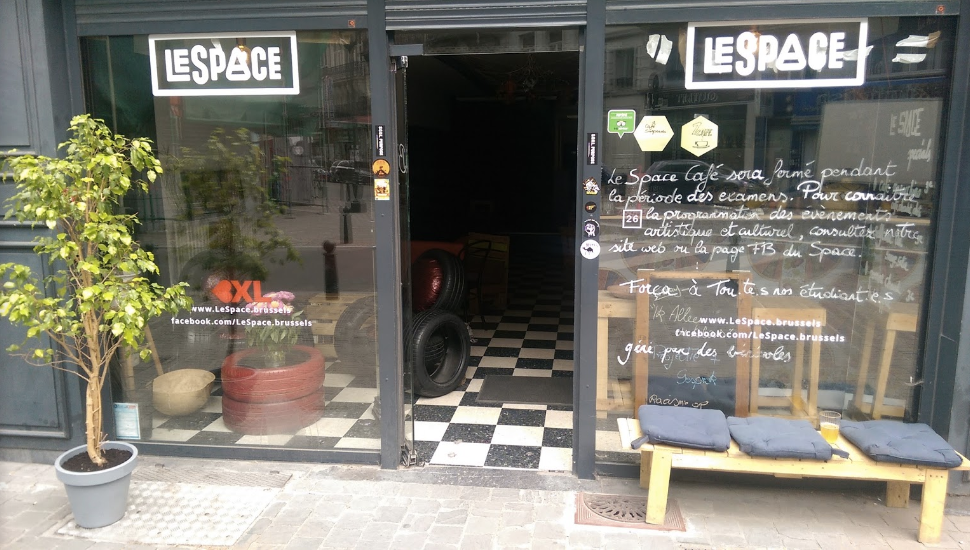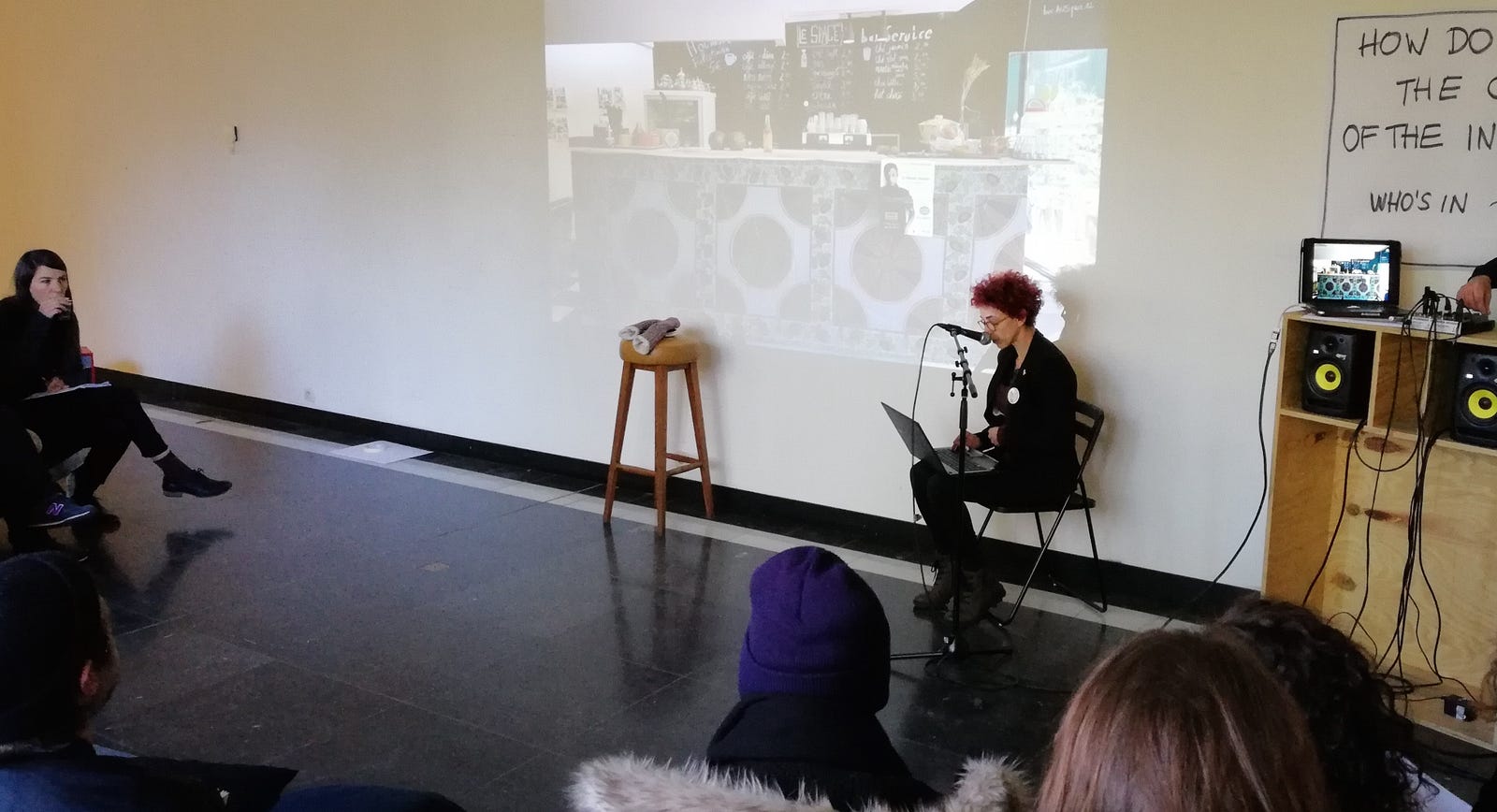Day 3 of the Return of the Fantastic Institution has the lead question “How do we define the content of our institutions?” As Daniel Blanga Gubbay introduced the Saturday meetings: usually institutions know well what they do, but would be less specific about what they don’t do. Or, more precisely, about where the limit lies of what they are dealing with. This question is closely connected with the one about ‘who is in and who is out’. Saturday morning was filled with powerful observations, statements and stories – by Rachida Aziz of Le Space in Brussels, Anne Breure of Veem House for Performance in Amsterdam and Aaron Wright of Fierce Festival in Birmingham. They left one to think, not to speak. Therefore, what follows is a report of one of these presentations, with no need for much selection, reformulation or added commentary. (And a coda).

The story of Le Space – Rachida Aziz
If you want to ‘diversify’ your institution, you should decolonize yourself, change your own patterns. Self inspect. Recognize your own ignorance. Serve instead of command. Listen instead of speak. Come down instead of expecting that they climb your mountain.
(Ignorance lies in phrases such as “we are the organized sector, we should reach out to the unorganized sector.” Ignorance lies in only realizing that already a couple of hundred organizations suffered from razzias when the police is at your own doorstep.)
There are many practices of diversification in the cultural sector, which can have negative or devastating effects.
The risks of co-opting. Co-opting is moving talents from the margin into the mainstream. There are a lot of collectives, people who build a counter power, in a fine-grained network. What often happens with co-opting is talent drain. The collectives take the blow and become more fragile than before. The co-opted artist gets isolated, while meeting with big expectations — that s/he would be able to open doors, will change the system from within etc. Which often leads to burn-out, disenchantment or a sense of betrayal.
Transfering problems from margin to mainstream. Moving people from the margins to the mainstream means transferring their problems from margin to mainstream. However, as institutions are mostly unaware of the realities these often fragile individuals come from, and are themselves operating in highly competitive logics, they are not safe environment, no environments for proper care.
Tokenism. The mechanism of tokenism works as follows: if you are part of a disadvantaged group, you are seen as a specimen of that group. What you say or do will always reflects on the other specimens of that group. In this logics, one person of color on a panel is enough, because s/he is representative for the others of the larger group.
Tokenism combines well with the celebration or the idea of ‘embracing diversity’ by adopting the superficial ‘multicultural’ approach, where people are ethicized, boxed in the category of the country of their grandparents. Another problematic approach at the other end is the one of simplified hybridity, where everyone is considered the combination of many different identities, erasing any recognition of power differences and discriminations.
Setting up projects to diversify, reaching for additional funds, and as a result draining funds away from the underground that actually needs it more.
What Le Space does is trying to be a negation of those practices.

Making a public has been the largest ‘production’ of Le Space. It makes no distinction between the artistic crew and the people working on ‘audience development’. It is seen as a symbiosis. Only 5 to 10% of the programming in Le Space is done by the crew. And this core group already consists of 20 different people. The rest is done by the large network. Also the way in which artists are put on stage offers people in the audience the idea that being an artist is not just for a special group of people. It could be something for them too. What happens in this context is the creation of new artistic expressions, based on the reality of people who have direct needs of expression. New formats that don’t fit in any of the pre-existing boxes.
Offer mental coaching. As Le Space works with marginalized and precarious people, who grow up in a hostile environment and who have to deal with traumas, the artists active in Le Space get mental coaching. This takes a lot of very close mentorship and accompanying the artists on a daily basis.
Constantly developing new strategies, moving between practice and theory and back. Le Space changes according to context, all the time, because the context changes so quickly. The way the larger, older institutions are being run has been defined decades ago, while society has changed drastically. It is impossible to define five years in advance what will be produced in Le Space and how it will be done. It is not only impossible, it is also unfavorable.
Constantly repairing fractures between different disadvantaged groups (think illness, gender, sexuality, race, class…). These fractures or segregation are nurtured in society; disadvantaged groups are set up against each other. Dealing with this, bringing people together across those fractures is hard work on a daily basis. It is about understanding the strategies with which these people are set up against each other, making people from marginalized groups realize how the oppression works and making them realize that they actually support the oppressive system when they fight against each other.
“It is too late to rely on the institutions operating with white people’s strategies to achieve the change we need. The gap between consciousness and practice is too big. The strategies in place now will only allow us to reach gender equality in 500 years. The same with racial discrimination, the ecological reality. As if we have the time!” “I am standing on the side where the suffering, misery, hunger and humiliation is a very real, daily reality. We don’t have time,” Rachida Aziz says. “The people leading the institutions are usually the ones who are the last one in line to receive the violence. (But they will receive it. They tend to believe that the system is there for them, but is not true. If you are not the 1%, it will come for you as well.)”
“Within Le Space, a lot of white people are active. But what we do is ‘post-’ the ancient system of patriarchy, racism. The men in the organization need to understand that they have to deconstruct themselves as the norm. We don’t speak anymore of ‘people who are white or black’, but ‘people who believe they are white’ and ‘people who believe they are black.’”
— — — — — — — —
As closing lecture of The Return of the Fantastic Institution, the wonderful Francis McKee of CCA Glasgow read his ‘The Rainbow Wrasse’, a short story that questions the future of art, institutions and artefacts in a future where climate change and its wide-ranging impact on societies and their infrastructure is resetting all our relationships.
He shared with us his believe in the power of fiction. “I am so fed up with theory. It is predictable and often has nothing to do with practice. In fiction, it is possible to speculate, to think through small steps and see what happens.” Writing a fictional story also was a strong exercise in empathy. “Me, an old white male trying to get into the head of two female characters, one actually being non-binary. It is hard-hard work. It is an attempt to respond to what we have been discussing these three days. It is not just a matter of shutting up.”


173 thoughts on “About (not) shutting up and listening”
Comments are closed.